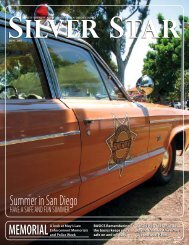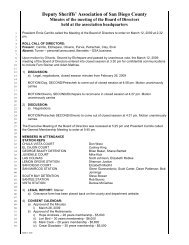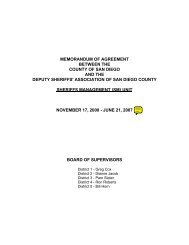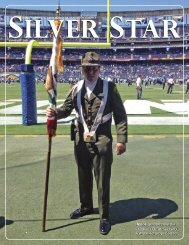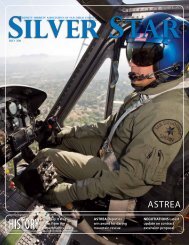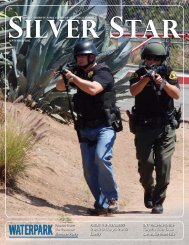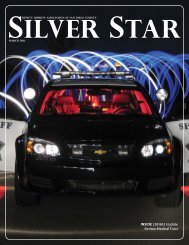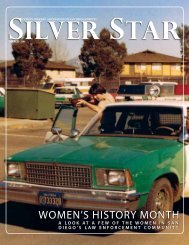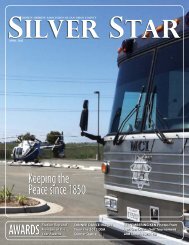Current Issue - Deputy Sheriffs' Association of San Diego County
Current Issue - Deputy Sheriffs' Association of San Diego County
Current Issue - Deputy Sheriffs' Association of San Diego County
You also want an ePaper? Increase the reach of your titles
YUMPU automatically turns print PDFs into web optimized ePapers that Google loves.
Check Your Ammo<br />
by Paul Markel, Officer.com<br />
Save Your Life<br />
With the benefit <strong>of</strong> hindsight firmly in my corner, I can say without<br />
a doubt that the lead firearms instructor at my police academy was<br />
decades ahead <strong>of</strong> most L.E. trainers. Though I’m sure he’s been<br />
promoted myriad times, Sgt. Doug Hunter gave us young police cadets<br />
much more information than was required by the book. Two decades<br />
later while living in southern Mississippi I’d discover a term for this—<br />
“lagniappe,” that little something extra.<br />
Doug gave us several lagniappes during the Ohio Peace Officer’s<br />
Training Academy. One <strong>of</strong> these was to remove any screws that might<br />
be found on our duty guns, clean the threads with alcohol and secure<br />
them back in place with some type <strong>of</strong> thread-locking compound.<br />
Damaged<br />
Winchester<br />
round direct<br />
from box<br />
Check your Ammo<br />
Another lesson not found in the manual was to<br />
visually inspect each and every round <strong>of</strong> duty<br />
ammunition issued to us before we loaded our<br />
magazines or speed-loaders (yes, some <strong>of</strong> us still had<br />
revolvers back then). Doug instructed us to check<br />
the primers and the cases and to give each piece a<br />
once over. He even went so far as to explain that<br />
when he swapped out old duty ammunition for new<br />
that he would sit down and manually drop each<br />
round into the chamber to ensure that it would seat<br />
properly when needed. This is readily accomplished<br />
by disassembling the pistol and using the barrel sans<br />
slide.<br />
I can recall a couple <strong>of</strong> guys sc<strong>of</strong>fing at that advice. They commented<br />
that they weren’t using basement reloads, but factory fresh ammunition.<br />
Surely the factory ammunition would be unquestionably the best<br />
available. While that was for the most part true twenty years ago,<br />
nevertheless, mistakes did and do happen.<br />
The Modern Ammo Crunch<br />
Twenty plus years ago, finding a piece <strong>of</strong> bad or damaged<br />
factory ammunition was like finding a four-leafed clover.<br />
You saved it and showed your friends. You remembered the<br />
exact day and circumstances. It was indeed rare.<br />
In the year 2013, every ammunition manufacturer in the<br />
nation is operating at maximum capacity. They simply<br />
cannot make ammo faster or in greater quantities. What<br />
this translates to in the real world is less experienced<br />
personnel running the machines and mistakes can and do<br />
happen.<br />
During the last few years there have been several voluntary recalls <strong>of</strong><br />
ammunition from all the big makers. The biggest culprit has been the<br />
use <strong>of</strong> the incorrect propellant. After a maker discovers that a lot <strong>of</strong><br />
ammo went out with the wrong powder they issue an immediate recall<br />
Factory fresh, flawed<br />
ammunition (left) hole<br />
in case, no powder<br />
(right) over-seated<br />
bullet, will not chamber<br />
and warning. But, what about a lot <strong>of</strong> ammo that might have had an<br />
inverted primer or two, does that lot get recalled? Perhaps one round<br />
out <strong>of</strong> ten thousands has the projectile over-seated? Will a recall be<br />
issued for that lot? Not likely, nor would it likely be warranted.<br />
During the last couple <strong>of</strong> months I’ve personally found pieces <strong>of</strong> factory<br />
fresh ammunition that were damaged in the manufacturing process but<br />
shipped out. About two months ago I discovered one round <strong>of</strong> .45 ACP<br />
that had a hole punched in the case wall and the propellant powder had<br />
all fallen out. A week ago as I write this, I encountered a piece <strong>of</strong> .45<br />
ACP that had the projectile seated too deeply causing the case wall to<br />
bulge ever so slightly. This round would not fully chamber.<br />
Just so you don’t think that .45 ACP ammo is the prime culprit I’ll<br />
share another experience. While working as a Small Arms and Tactics<br />
instructor for the military I personally found a few rounds <strong>of</strong> 9 mm<br />
that, despite being chambered and having their primers dented, failed<br />
to ignite. Not just once, but they failed after being rechambered by an<br />
instructor later on. This was Mil-Spec 9x19 mm ammunition from a<br />
major ammo maker.<br />
The Solution<br />
First and foremost, if you are loading your personal defense firearm<br />
with ammunition you will potentially be using to save your life, I would<br />
visually inspect every piece. Taking each round and dropping it in the<br />
chamber is solid advice as well. If you really want to get serious, use a<br />
digital grain scale and weigh each and every round. If you find a round<br />
that is a few grains <strong>of</strong>f that might indicate a low or empty charge.<br />
Insure that the ammunition you are using is the premium<br />
grade version from your favorite ammo maker. As a general<br />
rule, higher quality control goes into the manufacture <strong>of</strong><br />
premium personal defense ammo. You may not have a<br />
choice in the matter, but it’s worth considering.<br />
Have a backup plan. Firearms and ammunition are merely<br />
tools made by the hands <strong>of</strong> men. While most are extremely<br />
reliable, your life is worth having a second option. Another<br />
lagniappe Doug gave us was the “two is one, one is none”<br />
rule for critical gear. Doug always advocated carrying two<br />
guns.<br />
In the end, it’s your life. Live it like you want to. For my<br />
part, I will check all the ammo I load when it might be “for<br />
real”. <br />
***<br />
Reprinted from Officer.com. Mr. Markel has been a firearms industry<br />
writer for twenty years and currently hosts and produces “Student <strong>of</strong><br />
the Gun” a television show dedicated to education, experience and the<br />
enjoyment <strong>of</strong> firearms.<br />
Witness to History: The ATF Raid at Waco<br />
On Feb. 7, 2013, the National Law Enforcement Museum hosted the<br />
sixth event in its Witness to History panel discussion series, held at the<br />
Pew Charitable Trusts Building in Washington, DC, and sponsored<br />
by Target®. The event marked the first time that agents <strong>of</strong> the Bureau<br />
<strong>of</strong> Alcohol, Tobacco, Firearms and Explosives (ATF)—on the ground<br />
when the 51-day raid began in Waco, Texas, on Feb. 28, 1993—have<br />
spoken publicly about their role in this tragic case.<br />
“We were honored to host yet another successful Witness to History<br />
event as part <strong>of</strong> our continuing series,” said National Law Enforcement<br />
Officers Memorial Fund Chairman & CEO Craig Floyd, who moderated<br />
the panel discussion. “Our excellent panel provided valuable insight,<br />
and each panelist shared his unique perspective on this seminal<br />
moment in law enforcement history.”<br />
Panel discussion included expert analysis and firsthand accounts<br />
from Bill Buford, ATF (ret.) Resident Agent in Charge, Little Rock<br />
Field Office; Pete Mastin, ATF (ret.) Special Agent in Charge, New<br />
Orleans Field Division;<br />
Jerry Petrilli, ATF (ret.)<br />
Resident Agent in Charge,<br />
Albuquerque Field Office;<br />
and Dick Reavis, Author<br />
<strong>of</strong> The Ashes <strong>of</strong> Waco:<br />
An Investigation. A Q&A<br />
session allowed audience<br />
members to interact with<br />
the panelists at the end <strong>of</strong><br />
the discussion.<br />
Acting ATF Director, B.<br />
Todd Jones, was also in<br />
attendance and shared his<br />
thoughts on the events<br />
at Waco to open up the Q&A portion <strong>of</strong> the program. “This was the<br />
biggest gunfight involving federal law enforcement in the history <strong>of</strong><br />
America,” he said. “The men who were there that day were all heroes, in<br />
my mind.”<br />
Each <strong>of</strong> the agents on the panel shared insight into what they felt went<br />
wrong, as well as how ATF has improved operations as a result <strong>of</strong> what<br />
happened at Waco. According to Mr. Buford, “One thing that came as<br />
a result <strong>of</strong> Waco, was a strong contingency plan. We have that for every<br />
operation we run now.”<br />
The Museum’s Witness to History series focuses on significant events<br />
in law enforcement history that shaped regional and national identity,<br />
told through narratives and accounts from those involved. The first<br />
five events focused on the 1963 shooting <strong>of</strong> President John F. Kennedy’s<br />
alleged assassin Lee Harvey Oswald in Dallas; the terrorist attacks <strong>of</strong><br />
September 11, 2001; the 1982 Air Florida Flight 90 crash in Washington,<br />
DC; the 1968 assassination <strong>of</strong> presidential candidate Robert F. Kennedy<br />
in Los Angeles; and the 2002 Washington, DC-area sniper attacks.<br />
The event, Witness to History: The ATF Raid at Waco, was open to the<br />
public, with about 150 guests in attendance. For more information<br />
about the National Law Enforcement Museum’s Witness to History<br />
program, visit www.LawEnforcementMuseum.org/WitnesstoHistory.<br />
Photos courtesy <strong>of</strong> the NLEOMF. <br />
14 Silver Star May 2013<br />
Silver Star May 2013 15



